Abstract
(1) Background: As the largest family of potassium transporters in plants, KT/HAK/KUP plays an important function in plant growth, development, and stress, especially for potassium-loving plants such as melon. (2) Methods: The members of the KT/HAK/KUP gene family in the melon genome were identified by bioinformatics technology. The gene structure, chromosome location, phylogeny, and expression analysis were comprehensively and systematically analyzed. (3) Results: The results showed that there are 14 members of the KT/HAK/KUP gene family in melon, which are distributed on seven chromosomes. Each member contains 3–11 introns and 4–12 exons, and could be divided into three distinct branches in phylogeny. The number of amino acid residues encoded by each member varies between 610 and 878. In terms of expression, after 12 h of chilling stress, most of the CmHAK genes were expressed in two melon varieties with different chilling resistances. The expression levels of CmHAK6 and CmHAK8 were downregulated in chilling-resistant varieties, but there was no significant change in chilling-sensitive varieties, indicating that CmHAK6 and CmHAK8 genes may play a negative regulatory role in chilling-resistant varieties. (4) Conclusions: The study provides a theoretical basis for in-depth analysis of the functions of KT/HAK/KUP gene family and cultivation of high-potassium stress-resistant melon varieties.
1. Introduction
Melon (Cucumis melo L.) is an important horticultural crop that belongs to the Cucurbitaceae family [1]. Melon is native to Persia (Iran) and its eastern and western neighbors, and is widely cultivated in temperate to tropical regions of the world [2]. Due to its fresh, tender, juicy flesh and sweet taste, it is deeply loved by widespread consumers [3]. Potassium plays an important role in the growth and stress responses of melon [2,4], and is one of the essential nutrients for plant growth, accounting for 2% to 7% of the total dry matter of plants [5]. Potassium can regulate the osmotic pressure of cells, balance the charge inside and outside the membrane, participate in the enzyme activity reaction, improve the photosynthetic reaction rate, and promote the transportation of sugar and protein synthesis in the plant. Potassium plays an important regulatory role in plant root growth, photosynthesis, stress resistance, water balance, and acid–base balance [6]. Research has shown that using cultivation techniques and other means can improve the efficiency of potassium utilization in melon, thereby promoting the improvement of melon quality and yield [7]. However, there have been no reports on the molecular mechanism of potassium ion absorption in melon [8]. Thus, studying the absorption and transport of potassium in melon has become a current research direction.
Plants absorb and transport potassium by two systems of potassium ion channel and transporters [9]. According to previous studies in Arabidopsis and rice, it has been determined that potassium transporters are mainly divided into four families: KEA, KT/HAK/KUP, Trk/HKT, and CHX. As the largest family of potassium transporters in plants, the KT/HAK/KUP gene family was first identified in Escherichia coli, known as the KUP transporter, and is responsible for potassium ion absorption. If found in soil yeast, it is called the HAK1 transporter, which has a high affinity for potassium ion [10]. The KT/HAK/KUP gene family generally contains 10–15 transmembrane regions with conserved potassium transport domains, mainly located in the cell membrane system and expressed in organs such as roots, stems, leaves, and fruits of plants [11]. The KT/HAK/KUP gene family consists of four subfamilies (I–IV), each with a relatively conservative structure and function. Subfamily I is mainly expressed in roots and participates in the absorption and transportation of potassium in the environment by plant roots. Subfamily II is mainly involved in physiological processes such as plant growth regulation. There are few reports on the functions of subfamilies III and IV [12].
The HAK gene family has a large number of members, mainly involved in the absorption and transportation of potassium in plants and the transportation of root auxin [13]. The functions of the HAK gene family in plants are highly conserved and play an important role in coping with stress [14]. The OsHAK5 gene in rice, when overexpressed, can increase its salt tolerance by transporting potassium from the underground to the aboveground parts. The AtHAK5 gene in Arabidopsis can respond to salt stress by regulating potassium transport [15]. The IbHAK8 gene in sweet potatoes is significantly upregulated under drought and salt stress, and it is speculated that this gene plays an important role in sweet potatoes’ resistance to drought and salt stress [16]. When wheat seedlings are exposed to potassium deficiency, high salt stress, and dehydration conditions, the expression level of the TaHAK gene family in wheat seedlings significantly increases or decreases [17]. Under salt and drought treatments, the expression of MtHAK2/6/7/12 in alfalfa was highly induced, indicating that the HAK gene plays a key role in alfalfa’s response to various abiotic stresses [18]. Thus far, the HAK gene family has been reported in Arabidopsis, rice, corn, wheat, soybean, potato, tomato, rapeseed, pear, cassava, chili pepper, pomegranate, banana, and apple, and some HAK genes have been cloned and the functions of gene products verified [19,20], but relevant research in melon has not yet been carried out.
In this study, according to the latest melon reference genome, the members of the KT/HAK/KUP gene family in the melon genome were identified through bioinformatics technology, and the gene structure, chromosome location, phylogeny, and expression analysis were comprehensively and systematically analyzed, aiming to provide a theoretical basis for in-depth analysis of the function of KT/HAK/KUP gene family and cultivation of high-potassium stress-resistant melon varieties.
2. Materials and Methods
2.1. Genome Wide Identification of CmHAK in Melon
To identify the HAK proteins of melon, the HAK protein sequences of Arabidopsis, Oryza sativa, Fragaria vesca, Vitis vinifera, and Capsicum annuum were obtained from the Phytozome (12.1; https://phytozome.jgi.doe.gov/pz/portal.html, accessed on 14 September 2022) database, which were taken as the construction of a hidden Markov model with HMMER 3.0 (this tool can be used to create probability models for protein and DNA sequence domain families, as well as annotate new sequences) (https://www.ebi.ac.uk/Tools/hmmer/search/phmmer/, accessed on 10 December 2022). Using this model, all putative HAK protein sequences from the melon genome database (https://www.ncbi.nlm.nih.gov/datasets/genome/GCF_025177605.1/, accessed on 14 September 2022) were identified. Next, the HAK family reference sequence was created using blastp (version: ncbi blast 2.10.1+) by aligning the sequences of these proteins (the e-value was set to 1 × 10−5). The alignment sequence was used as the candidate HAK family sequence. These sequences were combined as candidate HAK protein sequences. Pfamscan (version: v1.6) and the Pfam A database (version: v33.1) were used to annotate the sequence domain obtained [21]. The 14 candidate CmHAK genes were numbered according to the ANSI (ANSI encoding is a character encoding standard used to map characters to corresponding integer values.) encoding method [22,23].
Subcellular localization was predicted using Softberry (http://linux1.softberry.com/berry.phtml?topic=protcomppl&group=programs&subgroup=proloc, accessed on 10 May 2022). The ExPASy website (http://web.expasy.org/protparam/, accessed on 10 May 2022) was used to determine the chemical and physical characteristics of the CmHAK proteins, including their molecular weight, amino acid count, isoelectric point (pI), GRAVY, instability index, and aliphatic index. The CmHAK members’ chromosomal positions were investigated using an easy-to-use web tool (http://mg2c.iask.in/mg2c_v2.1/, accessed on 10 May 2022, Chinese Academy of Agricultural Sciences, Qingdao, China). Based on various artificial neural network algorithms, SignalP 4.0 [24] software was used to predict the hidden position of the CmHAK protein in the given amino acid sequence and the cutting site of the signal peptide. The transmembrane signal of PbrLhc was predicted using the transmembrane prediction tool DeepTMHMM (version: v1.0.8, https://dtu.biolib.com/DeepTMHMM, accessed on 10 May 2022).
2.2. Classification, Structural, and Cis-Element of the Promoter Region Analysis of CmHAK Genes
The Gene Structure Display Server (http://gsds.gao-lab.org/, accessed on 10 May 2022, Peking University, Beijing, China) was utilized to analyze the CmHAK gene structures. The MEME software (v5.0.5, http://meme.nbcr.net/meme, accessed on 10 May 2022, University of Nevada, Reno, NV, USA), was used to find the common motifs, with the maximum number of motifs set to 15 and the ideal motif width set between 6 and 20. The PlantRegMap database was utilized to analyze putative TF binding sites in the 2 kb promoter regulatory region sequences upstream of the CmHAK beginning point [25]. The species chosen was melon, and the e-value was set at 1 × 10−4.
2.3. Phylogenetic Tree of CmHAK Genes
Multiple alignments of amino acid sequences were performed using ClustalW [26]. With the use of MAFFT (version: v1.6) software, the protein sequences of HAK family genes from six species (melon, Arabidopsis, rice, chili peppers, grapes, and strawberries) were aligned using the default settings. Finally, these HAK protein sequences were used to create a phylogenetic tree, which was then visualized by MEGA7.0 using the neighbor-joining method with 1000 bootstrap replicates.
2.4. Collinearity, Ka/Ks, and Expression Pattern Analysis
MCScanX (version: v2) software was used to analyze the collinearity of the CmHAK gene [27], and Circos (version: v2) software was used to visualize the obtained data and information. Utilizing KaKs_Calculator2.0 [28], we predicted the selection pressure of the PbrLhc protein. The RNA-seq data of CmHAK genes under different chilling stress conditions were obtained from the melon transcriptome database (https://peerj.com/articles/12921/#supp-4, accessed on 14 January 2023) [29], the data were analyzed using MAV (version: v1.1) software, and a clustering heat map of expression was generated using the hierarchical clustering (HCL) method.
3. Results
3.1. Identification of CmHAK Genes
A total of 14 CmHAK genes were identified. The genes were named from CmHAK1 to CmHAK14. All of the 14 CmHAK gene and protein sequences are shown in Supplemental Table S1. As shown in Table 1, these results contain the gene identifier in the genome database, chromosomal location, and some basic genetic properties. The amino acid lengths of these CmHAKs were determined to be between 610 and 878 aa. CmHAK13 was identified to be the smallest protein, with 610 aa, whereas the largest one was CmHAK12 (878 aa). The pIs were between 5.48 and 9.15, and the molecular weights ranged from 68,685.45 to 99,060.22 Da. Among these results, the pI of CmHAK10 was the lowest, whereas the pI of CmHAK5 was the highest. All CmHAK proteins were predicted to have no signal peptides and only have one transcript. Further analyses indicated that most of CmHAK proteins contain 12 transmembrane regions (TMRs), but CmHAK5 and CmHAK13 were predicted to have 10 and 8 TMRs, respectively (Table 1; Figure S1).

Table 1.
Statistical table of family member information.
In addition, subcellular localization of all CmHAK proteins were predicted in plasma membrane. The genetic mapping of CmHAK genes to the chromosomes was carried out according to the genome data (Figure 1). These 14 CmHAKs were randomly located on seven different chromosomes. CmHAK8–10 were located on chromosome 07 and CmHAK4, 10, 11 were located on chromosome 10. Meanwhile, there were three genes located on chromosome 12: CmHAK1, 2, and 12. Two genes, CmHAK6 and CmHAK7, were located in close proximity on chromosome 01, indicating that the two genes were a pair of tandem duplication genes. CmHAK3, 5, and 13 were located on chromosomes 04, 06, and 09, respectively.
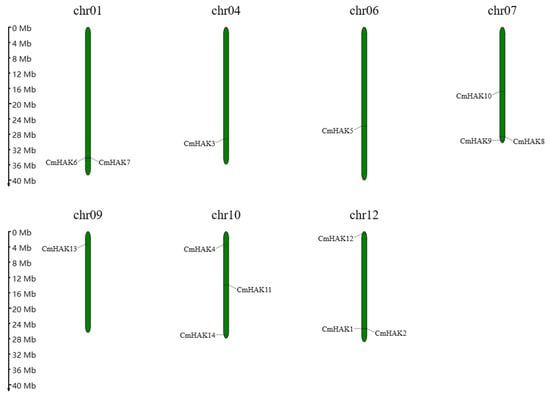
Figure 1.
Chromosome locations of CmHAK genes in the melon genome. The physical location map was drawn based on the location of the CmHAK genes on the chromosomes by MG2G.
3.2. Classification and Structural Analysis of CmHAK Genes
To analyze the gene structure of CmHAKs, the exon–intron organizations of all the identified CmHAK genes were examined to gain more insight into the evolution of the CmHAK family in melon. The results revealed that differences in the exon/intron structures of the different CmHAK genes were apparent (Figure 2). Among these, CmHAK1–3, CmHAK7, and CmHAK8 had eight exons. There were seven exons in four genes, including CmHAK4–6 and CmHAK9. CmHAK11 and CmHAK14 had nine exons. Additionally, CmHAK13 contained four exons; CmHAK10 had ten exons, and the number of exons in CmHAK12 was twelve. Genes with only one exon were not observed.
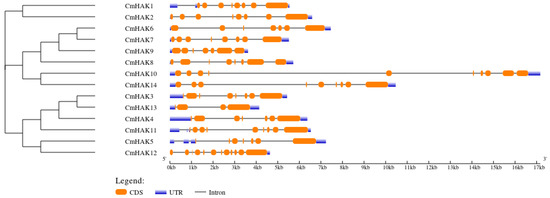
Figure 2.
Structure of CmHAK genes. Introns, exons, and untranslated regions (UTRs) are represented by black lines, deep orange boxes, and blue boxes, respectively.
To further study the conserved domain of CmHAK proteins in melon, multiple alignment of amino acid sequences of the CmHAK proteins were used to identify the conserved protein motifs (Figure 3 and Figure 4). As shown in Figure 4, the sequences in the CmHAK domain were highly conserved. A total of 15 conserved motifs were found in CmHAK genes. Different members had different conserved motifs. There were twelve CmHAK genes that contained motifs 1–15. However, CmHAK13 had only eleven motifs, excluding motifs 4, 7, 12, and 14. Additionally, except for motifs 3, 9, and 11, the rest were included in CmHAK5 proteins.
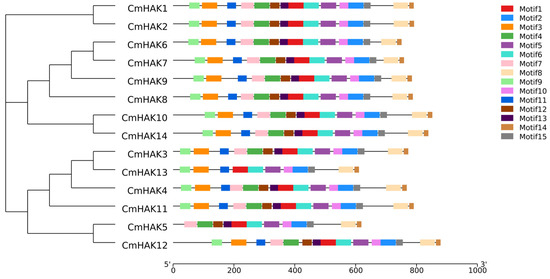
Figure 3.
CmHAK genes family motifs in melon. The various conserved motifs are labeled with colored boxes.
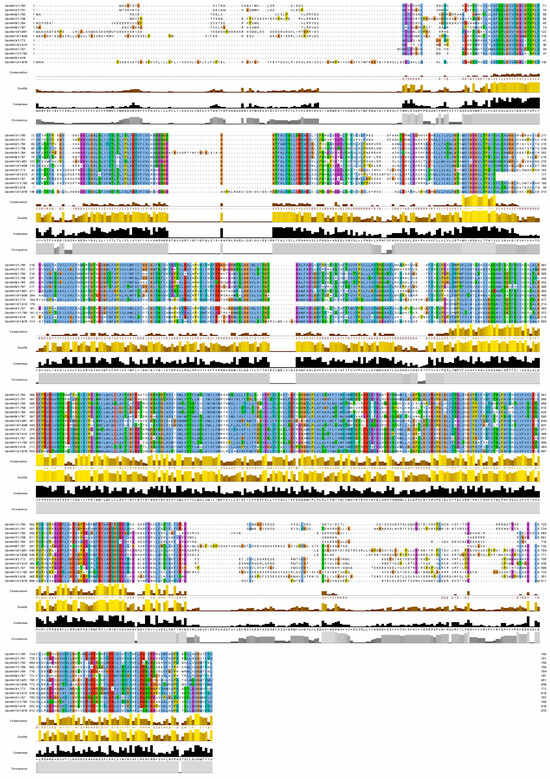
Figure 4.
Multiple sequence alignment of CmHAK genes family in melon.
To further understand the transcriptional regulation of CmHAK genes, 2000 bp upstream of their coding regions were predicted by PlantCARE. As shown in Figure 5, a total of 12 cis-effects were identified in the promoter region of CmHAK genes. In general, the elements of plant promoters that respond to external stimuli can be roughly divided into four categories: plant growth and development elements, light response elements, stress response elements, and hormone response elements. All of the 14 CmHAK genes contained TATA and CAAT elements related to plant growth and development as well as light-responsive elements. Several TF-binding sites were found in their promoter regions, such as ARE, MYB, MYC, ERE, etc. (Figure S2; Figure 5), and all of the 14 CmHAK genes contained at least one stress-responsive element. The results indicated that the expression of given genes might be regulated by these TFs.
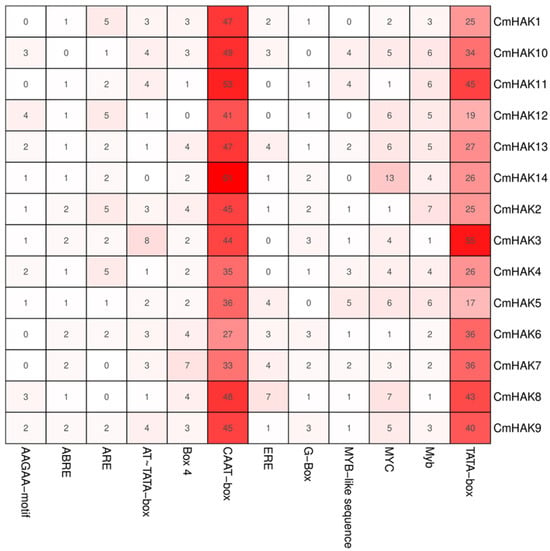
Figure 5.
Promoter element prediction analysis of CmHAK genes. Transcription factor binding sites within a region 2000 bp upstream of CmHAKs start site was predicted. Only the top 12 transcription factor families are shown. The number of putative TF sites in the promoters of CmHAK genes are marked.
3.3. Phylogenetic Analysis of CmHAK Genes
In order to analyze the evolutionary relationships between CmHAK proteins, the HAK proteins of Arabidopsis thaliana and Cucumis melo were used to construct a phylogenetic tree using MEGA 7.0 software. The phylogenetic analysis indicated that the HAK domains between Arabidopsis thaliana and Cucumis melo could be divided into three large groups corresponding to groups I, II, and III (Figure 6). Groups II and III were further divided into two categories. Among the 14 CmHAK proteins, CmHAK6–9 and AtHAK5 belonged to group IA, and AtHAK5 plays a physiological role in plants at very low K+ concentrations and provides a cesium uptake pathway in Arabidopsis [30]. CmHAK5, 12 and AtHAK1, 3, 4 belonged to group IIA; CmHAK3, 4, 11, and 14 were divided into group IIB and contained AtHAK2, 6, and 8. AtHAK4 mutations lead to impaired Arabidopsis auxin transport, and AtKUP2 (shy3-1) mutations reduce bud cell expansion [31,32]. While the remaining CmHAK proteins were in group III, such as CmHAK1 and 2 belonging to group IIIA, CmHAK10 and 14 were divided into group IIIB.
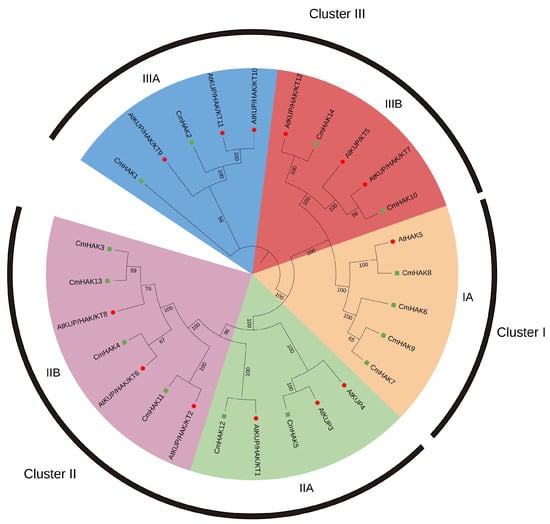
Figure 6.
Phylogenetic tree of the HAK gene family between Arabidopsis thaliana and Cucumis melo.
To further analyze the evolutionary relationships of CmHAK proteins among different species, the CmHAK proteins of Arabidopsis thaliana, Oryza sativa, Fragaria vesca, Vitis vinifera, Capsicum annuum, and Cucumis melo were used to construct a phylogenetic tree. The results indicated that the HAK domains in five species could be divided into four large groups corresponding to groups I, II, III, and IV (Figure S3). Each group was further divided into two categories. However, the 14 CmHAK proteins in Cucumis melo still belonged to groups I, II, and III. The results of the phylogenetic analysis showed that most of the CmHAK proteins were similar in sequence and origin. Therefore, we conclude that the CmHAK proteins were highly evolutionarily conserved. These results will provide important support for the further analysis of CmHAK genes.
3.4. Collinearity and Ka/Ks Analysis of CmHAK
Gene replication is a basic process of gene family evolution that plays an important role in species differentiation and diversity. A collinearity analysis of the 14 identified CmHAK family members was performed between different CmHAK genes, and the results demonstrated that there was a collinearity relationship between some CmHAK genes, such as between CmHAK3 and CmHAK4, CmHAK3 and CmHAK13, and CmHAK4 and CmHAK13 (Figure 7). This indicates that some CmHAK genes may be generated by gene replication, and fragment replication events may be one of the main driving forces for the evolution of the CmHAK gene family.
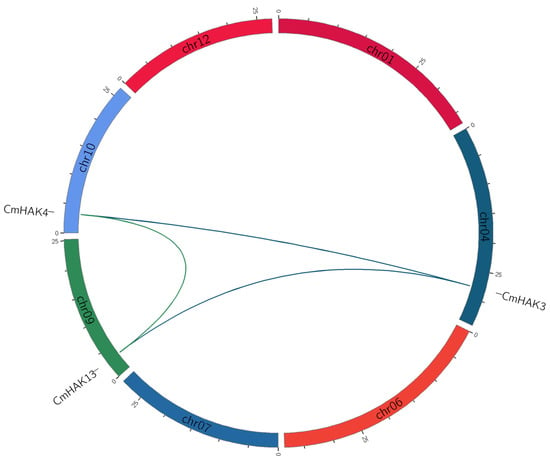
Figure 7.
Collinearity analysis of the 14 identified CmHAK genes.
Ka/Ks represents the ratio between the nonsynonymous substitution rate (Ka) and synonymous substitution rate (Ks) of two protein-coding genes. If the Ka/Ks value is equal to 1, it indicates that the gene has mainly experienced neutral selection after replication. If the Ka/Ks value is greater than 1, it indicates that the gene mainly undergoes positive selection after replication. If the Ka/Ks value is less than 1, it indicates that the gene mainly undergoes purification selection after replication [33]. The results showed that the Ka/Ks values of these three pairs of genes (CmHAK3/CmHAK4, CmHAK3/CmHAK13, and CmHAK4/CmHAK13) were all less than 1, and they mainly experienced purification selection after replication events (Table 2).

Table 2.
Characteristics of CmHAK genes in melon.
3.5. Gene Expression Analysis
Based on the previous chilling stress transcriptome data of melon [21], the potential function of the CmHAK protein was explored. The expression heat maps of 14 CmHAK genes were constructed under 0 h and 12 h of chilling stress in two varieties, chilling-tolerant (162) and chilling-sensitive (13-5A). The results showed that after 12 h of chilling treatment, the expression levels of CmHAK1, CmHAK2, CmHAK3, and CmHAK4 in the tolerant varieties (162) were upregulated, while the remaining CmHAK genes were downregulated (Figure 8). The expression levels of CmHAK1, CmHAK2, CmHAK3, CmHAK4, CmHAK5, CmHAK7, and CmHAK12 were upregulated in the sensitive varieties, while CmHAK6 and CmHAK8 did not significantly change, and the remaining CmHAK genes were downregulated. In summary, the expression levels of most CmHAK genes in “162” and “13-5A” changed after 12 h of cold storage treatment, indicating that some of these CmHAK genes may be involved in regulating the response of melon to chilling stress. CmHAK6 and CmHAK8 were downregulated in chilling-tolerant materials and remained unchanged in chilling-sensitive materials, and the different expression levels of these two genes in different cold-resistant materials may affect the tolerance of muskmelon to chilling pressure and have a negative regulatory effect.
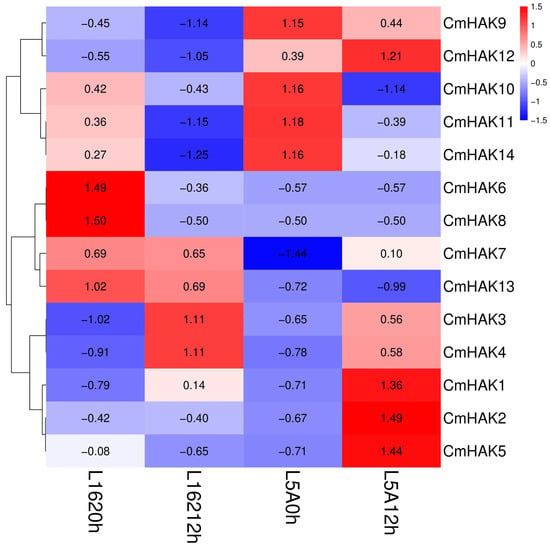
Figure 8.
Heatmap cluster analysis of the FPKM of CmHAK genes during the chilling stress of melon. L162—chilling-tolerant varieties (162); L5A—chilling-sensitive varieties (13-5A) [29].
4. Discussion
Melon has a short cultivation cycle, simple cultivation techniques, the ability to be intercropped with other crops, a relatively high land use efficiency and multiple cropping index, strong production adaptability, a large market demand, and high economic benefits, making it an efficient and economic fruit crop [2]. As one of the three major chemical elements necessary for plant growth, potassium plays an important role in regulating plant growth and development and participating in plant stress responses [6]. At present, KUP/HAK/KT family genes have been identified or cloned in the whole genome of many species. However, there is little research on the potassium transporter gene family in melon, and there is no report on the whole genome identification and analysis of large HAK family genes [11]. In this study, we identified 14 CmHAK genes from the whole melon genome data. The number of CmHAK genes in melon was similar to that in Arabidopsis, tomatoes, and peaches, but lower than that in rice, corn, soybeans, etc. [34,35,36,37,38].
The localization of all CmHAK proteins was predicted in the plasma membrane, which is consistent with previous research on soybean KUP/HAK/KT, indicating that CmHAK proteins may play a role in potassium ion transport upstream of the plasma membrane [36]. The gene family of melon CmHAKs encodes 610–878 amino acids; the relative molecular weight of protein is 68,685–94,840 Da; and the theoretical isoelectric point is 5.48–9.15. The gene coding length, the number of introns and exons, the type and number of conserved order types, the transmembrane domain, and the signal peptide are highly conserved, which may be the reason why HAKs of melon are highly conserved. In this study, we found that 14 members of the CmHAK gene family were evenly distributed on 7 chromosomes through chromosome mapping, and 3 of them had gene collinearity, which may be caused by gene replication. Gene replication events can lead to the formation of a large number of duplicate genes in the plant genome, and the presence of duplicate genes can promote the evolution of new gene functions and enhance the adaptability of plants to environmental changes [39]. The three collinear genes may be an evolutionary mechanism for muskmelon to adapt to high potassium demands.
The phylogenetic analysis of HAK/KUP/KT in melon and other species (Arabidopsis, rice, strawberries, chili peppers, and grapes) revealed that the HAK/KUP/KT family can be divided into four groups, each of which can be divided into four subgroups. Among them, group II has the most members, group IV contains the fewest members, and group IV does not contain the HAK family genes in melon. The evolutionary relationship between HAK/KUP/KT proteins in melon and these plants was relatively close [12]. The predictive analysis of the promoter elements of the CmHAK gene includes elements related to plant growth and stress response elements, such as TATA and MYB elements, indicating that some growth regulatory or biotic and abiotic stress transcription factors can bind to the promoter of CmHAK, driving or inhibiting the expression of CmHAK.
Previous studies have shown that HAK/KUP/KT genes are involved in K+ absorption, transport, salt tolerance, osmotic regulation, plant hormone responses, and abiotic stress [17]. The AtKUP/HAK/KT2 mutation has been shown to lead to shortened hypocotyls [40], while knocking out AtKUP3 leads to an increase in root hairs [41], indicating that CmHAK11 and CmHAK5, which are homologous to AtKUP/HAK/KT2 and AtKUP3, may play an important role in the growth and development of melon. The expression of AtHAK5 is induced by low K+ stress [35], and CmHAK8 is homologous to AtKUP5, indicating that CmHAK8 may also be induced by low K+ stress. The K+ transporter protein coding genes may also be involved in salt stress regulation, such as AtKUP/HAK/KT1, AtKUP/HAK/KT2, and AtKUP/HAK/KT6 in Arabidopsis [35], and their homologs CmHAK12, CmHAK11, and CmHAK4 may also be involved in salt stress regulation in melon. AtKUP/HAK/KT2 and AtKUP/HAK/KT6 of Arabidopsis are involved in root K+ efflux [42], and CmHAK4, CmHAK3, and CmHAK13, which share high homology with them, may be involved in K+ transport in melon roots. AtKUP3 is strongly induced by K+ starvation [43], and CmHAK5 is homologous to AtKUP3, indicating that CmHAK5 may also have a K+-starvation-induced expression pattern.
In addition, overexpression of the OsHAK5 gene in tobacco can further improve salt tolerance by enhancing the transport capacity of K+ from underground to aboveground parts [44]. There is a significant difference in the expression level of the PhaHAK2 gene in reed between salt-tolerant materials and controls [45]. Multiple genes such as AtHAK5, AtKUP4, and AtKUP11 in Arabidopsis are highly expressed in plants under salt stress [46,47]. The optimal growth temperature for muskmelon is 25–32 °C, and its main production area is in the northwest region of China, which is often affected by low temperatures. Therefore, it is crucial to cultivate cold-resistant varieties of melon. In this research, transcriptome analysis of two melon varieties with different cold resistance (“162”, chilling-tolerant; “13-5A”, chilling-sensitive) at 0 h and 12 h of chilling stress showed that most of the CmHAK genes were expressed. Among them, the expression of CmHAK6 and CmHAK8 genes belonging to group I, subgroup IB, was downregulated in chilling-tolerant varieties, but there was no obvious change in chilling-sensitive varieties. It may be that these two genes have different structures in different resistant varieties or that the expression patterns of key cold tolerance genes are different, resulting in inconsistent functions. When melon is subjected to cold stimulation, the CmHAK6 and CmHAK8 genes of chilling-resistant varieties are downregulated in response to stress, negatively regulating the cold resistance of plants. Therefore, the HAK genes of different species in the group I and IB subgroups may play a role under cold stress.
In this study, we systematically analyzed the members of each family of melon HAK/KUP/KT from the aspects of identification, chromosome location, gene structure, phylogeny, and expression mode of members of the gene family, and screened out the members that mainly express cold stimulation. The results provide a theoretical basis for further study of the function of the KT/HAK/KUP gene family and cultivating melon varieties with high potassium tolerance.
5. Conclusions
To study the biological functions of the Cucumis melo potassium transferrin (KT/HAK/KUP) gene family in growth, development, and stress, 14 members of the KT/HAK/KUP gene family were identified from the melon genome using bioinformatics, and a comprehensive and systematic analysis was carried out from the aspects of gene structure, chromosome location, phylogeny, and expression analysis. The results showed that 14 members of the KT/HAK/KUP gene family were distributed on seven chromosomes, and the number of amino acid residues encoded by each member varied from 610 to 878. The molecular weight of these proteins was 68.69–94.84 kDa, and the protein products were located on the cytoplasmic membrane. There are 3–11 introns and 4–12 exons in 14 CmHAKs, and they are divided into four distinct branches in phylogeny. In terms of expression, after 12 h of chilling stress, most of the CmHAK genes were expressed in two melon varieties with different chilling resistances. The expression levels of CmHAK6 and CmHAK8 genes were downregulated in chilling-resistant varieties, but there was no significant change in chilling-sensitive varieties, indicating that CmHAK6 and CmHAK8 genes may play a negative regulatory role in chilling-resistant varieties. The results provide a theoretical basis for in-depth analysis of the functions of the KT, HAK, and KUP gene families, as well as for the cultivation of melon varieties under high potassium stress to improve yield and quality.
Supplementary Materials
The following supporting information can be downloaded at: https://www.mdpi.com/article/10.3390/horticulturae9101138/s1, Figure S1: Number of predicted TMRs of 14 CmHAK proteins in Cucumis melo; Figure S2. Promoter element prediction analysis of CmHAK genes; Figure S3. Phylogenetic tree of the HAK gene family. At—Arabidopsis thaliana; Os—Oryza sativa; Fve—Fragaria vesca; Vv—Vitis vinifera; Ca—Capsicum annuum; Cm—Cucumis melo. Table S1: CDS and protein sequence of CmHAK genes in melon.
Author Contributions
Conceptualization, W.W. and C.W.; methodology, H.W.; software, X.Z.; validation, B.X.; formal analysis, H.L.; investigation, L.F.; resources, W.W.; data curation, D.X.; writing—original draft preparation, L.F.; writing—review and editing, W.W.; visualization, Y.W.; supervision, X.L.; project administration, C.W.; funding acquisition, W.W. All authors have read and agreed to the published version of the manuscript.
Funding
This research was funded by Jilin Province Agricultural Major Technology Collaborative Promotion Project (2023).
Data Availability Statement
Not applicable.
Conflicts of Interest
The authors declare no conflict of interest.
References
- Fatima, P.; Nadeem, M.; Hussain, A.; Kausar, T.; Rehman, A.; Siddique, T.; Kabir, K.; Noreen, S.; Nisar, R.; Fatima, H.; et al. Synergistic effect of microwave heating and thermosonication on the physicochemical and nutritional quality of muskmelon and sugarcane juice blend. Food Chem. 2023, 425, 136489. [Google Scholar] [CrossRef] [PubMed]
- Xue, S.; Bi, Y.; Ackah, S.; Li, Z.; Li, B.; Wang, B.; Wang, Y.; Li, Y.; Prusky, D. Sodium silicate treatment accelerates biosynthesis and polymerization of suberin polyaliphatics monomers at wounds of muskmelon. Food Chem. 2023, 417, 135847. [Google Scholar] [CrossRef] [PubMed]
- Liu, Y.; Zhang, X.; Liu, S.; Zhu, X.; Xia, J. First report of muskmelon fruit rot caused by Fusarium sulawesiense in China. Plant Dis. 2023. [Google Scholar] [CrossRef] [PubMed]
- Vella, F.M.; Calandrelli, R.; Cautela, D.; Laratta, B. Natural antioxidant potential of melon peels for fortified foods. Foods 2023, 12, 2523. [Google Scholar] [CrossRef] [PubMed]
- Ankit, A.; Kamali, S.; Singh, A. Genomic & structural diversity and functional role of potassium (K) transport proteins in plants. Int. J. Biol. Macromol. 2022, 208, 844–857. [Google Scholar] [PubMed]
- Liang, M.; Gao, Y.; Mao, T.; Zhang, X.; Zhang, S.; Zhang, H.; Song, Z. Characterization and expression of KT/HAK/KUP transporter family genes in willow under potassium deficiency, drought, and salt stresses. BioMed Res. Int. 2020, 2020, 2690760. [Google Scholar] [CrossRef] [PubMed]
- Zhao, Y.; Wang, L.; Zhao, P.; Liu, Z.; Guo, S.; Li, Y.; Liu, H. Genome-wide identification, characterization and expression analysis of HAK genes and decoding their role in responding to potassium deficiency and abiotic stress in Medicago truncatula. PeerJ 2022, 10, e14034. [Google Scholar] [CrossRef]
- Yang, T.; Lu, X.; Wang, Y.; Xie, Y.; Ma, J.; Cheng, X.; Xia, E.; Wan, X.; Zhang, Z. HAK/KUP/KT family potassium transporter genes are involved in potassium deficiency and stress responses in tea plants (Camellia sinensis L.): Expression and functional analysis. BMC Genom. 2020, 21, 556. [Google Scholar] [CrossRef]
- Wang, Y.; Zhang, Y.; Wei, Y.; Meng, J.; Zhong, C.; Fan, C. Characterization of HAK protein family in Casuarina equisetifolia and the positive regulatory role of CeqHAK6 and CeqHAK11 genes in response to salt tolerance. Front. Plant Sci. 2023, 13, 1084337. [Google Scholar] [CrossRef]
- Shen, L.; Fan, W.; Li, N.; Wu, Q.; Chen, D.; Luan, J.; Zhang, G.; Tian, Q.; Jing, W.; Zhang, Q.; et al. Rice potassium transporter OsHAK18 mediates phloem K loading and redistribution. Plant J. 2023, 116, 201–216. [Google Scholar] [CrossRef]
- Templalexis, D.; Tsitsekian, D.; Liu, C.; Daras, G.; Šimura, J.; Moschou, P.; Ljung, K.; Hatzopoulos, P.; Rigas, S. Potassium transporter TRH1/KUP4 contributes to distinct auxin-mediated root system architecture responses. Plant Physiol. 2022, 188, 1043–1060. [Google Scholar] [CrossRef] [PubMed]
- Amo, J.; Lara, A.; Martínez-Martínez, A.; Martínez, V.; Rubio, F.; Nieves-Cordones, M. The protein kinase SlCIPK23 boosts K+ and Na+ uptake in tomato plants. Plant Cell Environ. 2021, 44, 3589–3605. [Google Scholar] [CrossRef] [PubMed]
- Peng, L.; Xiao, H.; Li, R.; Zeng, Y.; Gu, M.; Moran, N.; Yu, L.; Xu, G. Potassium transporter OsHAK18 mediates potassium and sodium circulation and sugar translocation in rice. Plant Physiol. 2023, kiad435. [Google Scholar] [CrossRef] [PubMed]
- Zhu, H.; Guo, J.; Ma, T.; Liu, S.; Zhou, Y.; Yang, X.; Li, Q.; Yu, K.; Wang, T.; He, S.; et al. The Sweet Potato K+ Transporter IbHAK11 Regulates K+ Deficiency and High Salinity Stress Tolerance by Maintaining Positive Ion Homeostasis. Plants 2023, 12, 2422. [Google Scholar] [CrossRef] [PubMed]
- Feng, H.; Tang, Q.; Cai, J.; Xu, B.; Xu, G.; Yu, L. Rice OsHAK16 functions in potassium uptake and translocation in shoot, maintaining potassium homeostasis and salt tolerance. Planta 2019, 250, 549–561. [Google Scholar] [CrossRef] [PubMed]
- Jin, R.; Jiang, W.; Yan, M.; Zhang, A.; Liu, M.; Zhao, P.; Chen, X.; Tang, Z. Genome-wide characterization and expression analysis of HAK K+ transport family in Ipomoea. 3 Biotech 2021, 11, 3. [Google Scholar] [CrossRef]
- Cheng, X.; Liu, X.; Mao, W.; Zhang, X.; Chen, S.; Zhan, K.; Bi, H.; Xu, H. Genome-Wide Identification and Analysis of HAK/KUP/KT Potassium Transporters Gene Family in Wheat (Triticum aestivum L.). Int. J. Mol. Sci. 2018, 19, 3969. [Google Scholar] [CrossRef] [PubMed]
- Li, Q.; Du, W.; Tian, X.; Jiang, W.; Zhang, B.; Wang, Y.; Pang, Y. Genome-wide characterization and expression analysis of the HAK gene family in response to abiotic stresses in Medicago. BMC Genom. 2022, 23, 791. [Google Scholar] [CrossRef] [PubMed]
- Greiner, T.; Ramos, J.; Alvarez, M.C.; Gurnon, J.R.; Kang, M.; Van Etten, J.L.; Moroni, A.; Thiel, G. Functional HAK/KUP/KT-like potassium transporter encoded by chlorella viruses. Plant J. 2011, 68, 977–986. [Google Scholar] [CrossRef]
- Xu, Y.; Zhu, Y.; Wang, X.; Hong, Z.; Yang, A.; Liu, Y.; Yan, L.; He, Y.; Zhu, Z.; Wang, H. PACLOBUTRAZOL-RESISTANCE4 positively regulates cell expansion to promote tendril elongation in cucumber. Plant Physiol. 2023, 192, 2756–2767. [Google Scholar] [CrossRef]
- Lamesch, P.; Berardini, T.Z.; Li, D.; Swarbreck, D.; Wilks, C.; Sasidharan, R.; Muller, R.; Dreher, K.; Alexander, D.L.; Garcia-Hernandez, M.; et al. The arabidopsis information resource (TAIR): Improved gene annotation and new tools. Nucleic Acids Res. 2012, 40, 1202–1210. [Google Scholar] [CrossRef] [PubMed]
- Zhang, Y.; Mao, Q.; Ma, R.; Xu, J.; Yu, M. Genome-Wide Identification and Expression Analysis of the PpYUCCA Gene Family in Weeping Peach Trees (Prunus persica ‘Pendula’). Horticulturae 2022, 8, 878. [Google Scholar] [CrossRef]
- Wu, R.; Ran, K.; Zhao, S.; Cheng, F. Genome-Wide Identification of the Light-Harvesting Chlorophyll a/b Binding Protein Gene Family in Pyrus bretschneideri and Their Transcriptomic Features under Drought Stress. Horticulturae 2023, 9, 522. [Google Scholar] [CrossRef]
- El-Gebali, S.; Mistry, J.; Bateman, A.; Eddy, S.R.; Luciani, A.; Potter, S.C.; Qureshi, M.; Richardson, L.J.; Salazar, G.A.; Smart, A.; et al. The Pfam protein families database in 2019. Nucleic Acids Res. 2019, 47, 427–432. [Google Scholar] [CrossRef] [PubMed]
- Petersen, T.N.; Brunak, S.; von Heijne, G.; Nielsen, H. SignalP 4.0: Discriminating signal peptides from transmembrane regions. Nat. Methods 2011, 8, 785–786. [Google Scholar] [CrossRef] [PubMed]
- Tian, F.; Yang, D.C.; Meng, Y.Q.; Jin, J.; Gao, G. PlantRegMap: Charting functional regulatory maps in plants. Nucleic Acids Res. 2020, 48, 1104–1113. [Google Scholar] [CrossRef]
- Hung, J.H.; Weng, Z. Sequence Alignment and Homology Search with BLAST and ClustalW. Cold Spring Harb. Protoc. 2016, 11. [Google Scholar] [CrossRef]
- Wang, Y.; Tang, H.; Debarry, J.D.; Tan, X.; Li, J.; Wang, X.; Lee, T.H.; Jin, H.; Marler, B.; Guo, H.; et al. MCScanX: A toolkit for detection and evolutionary analysis of gene synteny and collinearity. Nucleic Acids Res. 2012, 40, e49. [Google Scholar] [CrossRef]
- Zhang, Z.; Li, J.; Zhao, X.Q.; Wang, J.; Wong, G.K.; Yu, J. KaKs_Calculator: Calculating Ka and Ks through model selection and model averaging. Genom. Proteom. Bioinform. 2006, 4, 259–263. [Google Scholar] [CrossRef]
- Zhi, Q.; Hampton, C.R.; Shin, R.; Barkla, B.J.; White, P.J.; Schachtman, D.P. The high affinity K+ transporter AtHAK5 plays a physiological role in planta at very low K+ concentrations and provides a caesium uptake pathway in Arabidopsis. J. Exp. Bot. 2008, 59, 595–607. [Google Scholar]
- Desbrosses, G.; Josefsson, C.; Rigas, S.; Hatzopoulos, P.; Dolan, L. AKT1 and TRH1 are required during root hair elongation in Arabidopsis. J. Exp. Bot. 2003, 54, 781–788. [Google Scholar] [CrossRef] [PubMed]
- Vicente-Agullo, F.; Rigas, S.; Desbrosses, G.; Dolan, L.; Hatzopoulos, P.; Grabov, A. Potassium carrier TRH1 is required for auxin transport in Arabidopsis roots. Plant J. 2004, 40, 523–535. [Google Scholar] [CrossRef] [PubMed]
- Holub, E.B. The arms race is ancient history in Arabidopsis, the wildflower. Nat. Rev. Genet. 2001, 2, 516–527. [Google Scholar] [CrossRef] [PubMed]
- Lynch, M.; Conery, J.S. The evolutionary fate and consequences of duplicate genes. Science 2000, 290, 1151–1155. [Google Scholar] [CrossRef] [PubMed]
- Gierth, M.; Mäser, P.; Schroeder, J.I. The potassium transporter AtHAK5 functions in K(+) deprivation-induced high-affinity K(+) uptake and AKT1 K(+) channel contribution to K(+) uptake kinetics in Arabidopsis roots. Plant Physiol. 2005, 137, 1105–1114. [Google Scholar] [CrossRef]
- Wang, Y.; Lü, J.; Chen, D.; Zhang, J.; Qi, K.; Cheng, R.; Zhang, H.; Zhang, S. Genome-wide identification, evolution, and expression analysis of the KT/HAK/KUP family in pear. Genome 2018, 61, 755–765. [Google Scholar] [CrossRef]
- Gupta, M.; Qiu, X.; Wang, L.; Xie, W.; Zhang, C.; Xiong, L.; Lian, X.; Zhang, Q. KT/HAK/KUP potassium transporters gene family and their whole-life cycle expression profile in rice (Oryza sativa). Mol. Genet. Genom. 2008, 280, 437–452. [Google Scholar] [CrossRef] [PubMed]
- Zhang, Z.; Zhang, J.; Chen, Y.; Li, R.; Wang, H.; Wei, J. Genome-wide analysis and identification of HAK potassium transporter gene family in maize (Zea mays L.). Mol. Biol. Rep. 2012, 39, 8465–8473. [Google Scholar] [CrossRef] [PubMed]
- Panchy, N.; Lehti-Shiu, M.; Shiu, S.H. Evolution of Gene Duplication in Plants. Plant Physiol. 2016, 171, 2294–2316. [Google Scholar] [CrossRef]
- Elumalai, R.P.; Nagpal, P.; Reed, J.W. A mutation in the Arabidopsis KT2/KUP2 potassium transporter gene affects shoot cell expansion. Plant Cell 2002, 14, 119–131. [Google Scholar] [CrossRef]
- Rigas, S.; Debrosses, G.; Haralampidis, K.; Vicente-Agullo, F.; Feldmann, K.A.; Grabov, A.; Dolan, L.; Hatzopoulos, P. TRH1 encodes a potassium transporter required for tip growth in Arabidopsis root hairs. Plant Cell 2001, 13, 139–151. [Google Scholar] [CrossRef] [PubMed]
- Osakabe, Y.; Arinaga, N.; Umezawa, T.; Katsura, S.; Nagamachi, K.; Tanaka, H.; Ohiraki, H.; Yamada, K.; Seo, S.-U.; Abo, M.; et al. Osmotic stress responses and plant growth controlled by potassium transporters in Arabidopsis. Plant Cell 2013, 25, 609–624. [Google Scholar] [CrossRef] [PubMed]
- Kim, E.J.; Kwak, J.M.; Uozumi, N.; Schroeder, J.I. AtKUP1: An Arabidopsis gene encoding high-affinity potassium transport activity. Plant Cell 1998, 10, 51–62. [Google Scholar] [CrossRef] [PubMed]
- Yang, T.; Zhang, S.; Hu, Y.; Wu, F.; Hu, Q.; Chen, G.; Cai, J.; Wu, T.; Moran, N.; Yu, L.; et al. The role of a potassium transporter OsHAK5 in potassium acquisition and transport from roots to shoots in rice at low potassium supply levels. Plant Physiol. 2014, 166, 945–959. [Google Scholar] [CrossRef]
- Takahashi, R.; Nishio, T.; Ichizen, N.; Takano, T. Cloning and functional analysis of the K+ transporter, PhaHAK2, from salt-sensitive and salt-tolerant reed plants. Biotechnol. Lett. 2007, 29, 501–506. [Google Scholar] [CrossRef]
- Maathuis, F.J.M. The role of monovalent cation transporters in plant responses to salinity. J. Exp. Bot. 2006, 57, 1137–1147. [Google Scholar] [CrossRef]
- Yang, T.; Feng, H.; Zhang, S.; Xiao, H.; Hu, Q.; Chen, G.; Xuan, W.; Moran, N.; Murphy, A.; Yu, L.; et al. The Potassium Transporter OsHAK5 Alters Rice Architecture via ATP-Dependent Transmembrane Auxin Fluxes. Plant Commun. 2020, 1, 1000–1005. [Google Scholar] [CrossRef]
Disclaimer/Publisher’s Note: The statements, opinions and data contained in all publications are solely those of the individual author(s) and contributor(s) and not of MDPI and/or the editor(s). MDPI and/or the editor(s) disclaim responsibility for any injury to people or property resulting from any ideas, methods, instructions or products referred to in the content. |
© 2023 by the authors. Licensee MDPI, Basel, Switzerland. This article is an open access article distributed under the terms and conditions of the Creative Commons Attribution (CC BY) license (https://creativecommons.org/licenses/by/4.0/).